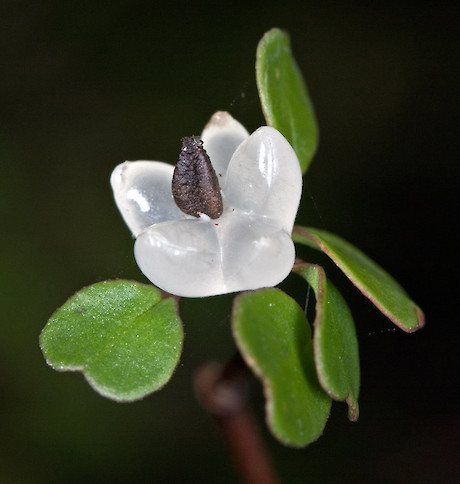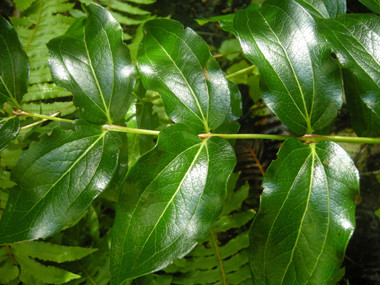 Muehlenbeckia astonii. Photo: Jeremy RolfeApproximately 28 species (4.8%) of the New Zealand woody flora have a marked loss of leaves in winter. Only 11 species are consistently fully winter deciduous (adults are entirely leafless, or nearly so, towards the end of winter) although juvenile plants in some populations may retain significant foliage during the winter. They are:
Muehlenbeckia astonii. Photo: Jeremy RolfeApproximately 28 species (4.8%) of the New Zealand woody flora have a marked loss of leaves in winter. Only 11 species are consistently fully winter deciduous (adults are entirely leafless, or nearly so, towards the end of winter) although juvenile plants in some populations may retain significant foliage during the winter. They are:
- Discaria toumatou
- Fuchsia excorticata
- Hoheria glabrata
- Hoheria lyallii
- Muehlenbeckia astonii
- Olearia fragantissima
- Olearia gardneri
- Olearia hectori
- Olearia odorata
- Plagianthus divaricatus
- Plagianthus regius subsp. regius
The following 11 species are best described as semi-deciduous, the degree of leaf loss varying markedly according to exposure, site, and geographic location:
 Coriaria arborea Makarora Valley. Photo: John Sawyer
Coriaria arborea Makarora Valley. Photo: John Sawyer
- Aristotelia serrata
- Carmichaelia odorata
- Carmichaelia arborea
- Coprosma virescens
- Coriaria arborea var. arborea
- Fuchsia perscandens
- Fuchsia procumbens
- Muehlenbeckia australis
- Muehlenbeckia complexa
- Olearia fimbriata
- Urtica ferox
Some populations of Sophora microphylla and Sophora tetraptera are brevideciduous meaning they lose their overwintering leaves in spring at the time of flowering and before the new leaves have flushed, but are otherwise annual evergreens.
Coriaria angustissima, C. plumosa, C. pottsiana, and C. sarmentosa are rhizomatous subshrubs in which the above-ground stem and leaves die back completely in winter. They are rarely included in lists of indigenous deciduous trees and shrubs because they have a herb-like appearance. However, they have woody rootstocks and should be regarded as deciduous shrubs.
For more information about deciduous trees see:
- McGlone et al. 2004. Winter leaf loss in the New Zealand woody flora. New Zealand Journal of Botany, 2004, Vol. 42: 1-19.
